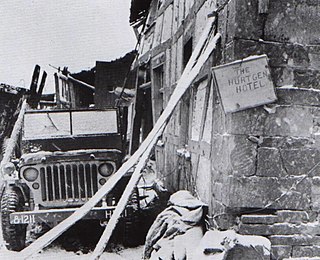
The Battle of Hürtgen Forest was a series of fierce battles fought from 19 September to 16 December 1944, between American and German forces on the Western Front during World War II, in the Hürtgen Forest, a 140 km2 (54 sq mi) area about 5 km (3.1 mi) east of the Belgian–German border. It was the longest battle on German ground during World War II and is the longest single battle the U.S. Army has ever fought.
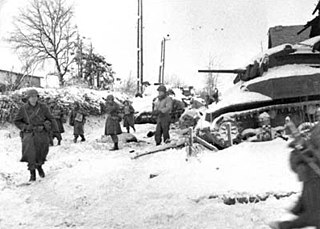
The Battle of the Bulge, also known as the Ardennes Counteroffensive, was the last major German offensive campaign on the Western Front during World War II, and took place from 16 December 1944 to 25 January 1945. It was launched through the densely forested Ardennes region of Wallonia in eastern Belgium, northeast France, and Luxembourg, towards the end of the war in Europe. The offensive was intended to stop Allied use of the Belgian port of Antwerp and to split the Allied lines, allowing the Germans to encircle and destroy four Allied armies and force the Western Allies to negotiate a peace treaty in the Axis powers' favor.

The 3rd Infantry Division is a combined arms and mechanized infantry division of the United States Army based at Fort Stewart, Georgia. It is a direct subordinate unit of the XVIII Airborne Corps and U.S. Army Forces Command. Its current organization includes one Infantry Brigade Combat Team and two armored brigade combat teams, one aviation brigade, a division artillery and support elements. The division has a distinguished history, having seen active service in both World War I and World War II.

The 2nd Armored Division was an armored division of the United States Army. The division played an important role during World War II in the invasions of North Africa and Sicily and the liberation of France, Belgium, and the Netherlands and the invasion of Germany. During the Cold War, the division was primarily based at Fort Hood, Texas, and had a reinforced brigade forward stationed in Garlsedt, West Germany. After participation in the Persian Gulf War, the division was inactivated in 1995.
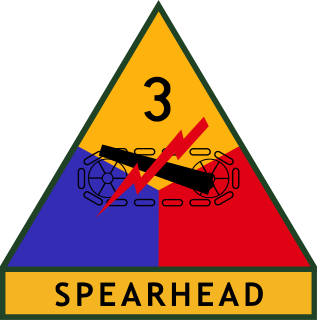
The 3rd Armored Division ("Spearhead") was an armored division of the United States Army. Unofficially nicknamed the "Third Herd," the division was first activated in 1941, and was active in the European Theater of World War II. The division was stationed in West Germany for much of the Cold War, and participated in the Persian Gulf War. On 17 January 1992, in Germany, the division ceased operations. In October 1992 it was formally inactivated as part of a general drawing down of forces at the end of the Cold War.

The 106th Infantry Division was a division of the United States Army formed for service during World War II. Two of its three regiments were overrun and surrounded in the initial days of the Battle of the Bulge, and they were forced to surrender to German forces on 19 December 1944. The division was never officially added to the troop list following the war, despite having been almost completely organized in Puerto Rico by 1948; subsequently, the War Department determined the division was not needed and inactivated the division headquarters in 1950.

The 28th Infantry Division ("Keystone") is a unit of the Army National Guard and is the oldest division-sized unit in the armed forces of the United States. Some of the units of the division can trace their lineage to Benjamin Franklin's battalion, The Pennsylvania Associators (1747–1777). The division was officially established in 1879 and was later redesignated as the 28th Division in 1917, after the entry of America into the First World War. It is today part of the Pennsylvania Army National Guard, Maryland Army National Guard, Ohio Army National Guard, and New Jersey Army National Guard.

The 105 mm Howitzer Motor Carriage M7 was an American self-propelled artillery vehicle produced during World War II. It was given the official service name 105 mm Self Propelled Gun, Priest by the British Army, due to the pulpit-like machine gun ring, and following on from the Bishop and the contemporary Deacon self-propelled guns.
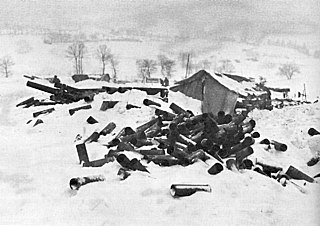
The Battle of Elsenborn Ridge refers to the northernmost German attacks during the Battle of the Bulge; the area from Elsenborn Ridge itself to Monschau was the only sector of the American front line attacked during the Battle of the Bulge where the Germans failed to advance. The battle centered on the boomerang-shaped Elsenborn Ridge east of Elsenborn, Belgium. In this region, Elsenborn Ridge marks the westernmost ridge of the Ardennes, rising more than 2,000 feet (600 m) above sea level; unlike the uplands further north, east and south, it has been extensively logged. West of Elsenborn Ridge, where the land descends in gentle hills to the cities of Liège and Spa, was a network of Allied supply bases and a well-developed road network. The Germans planned on using two key routes through the area to seize Antwerp and force a separate peace with the United States and Britain. Capturing Monschau, the nearby village of Höfen, and the twin villages of Rocherath-Krinkelt just east of Elsenborn Ridge, were key to the success of the German plans, and Hitler committed his best armored units to the area.
The Battle of Lanzerath Ridge was fought on December 16, 1944, the first day of the Battle of the Bulge during World War II, near the village of Lanzerath, Belgium, along the key route for the German advance on the northern shoulder of the operation. It was fought between two squads totalling 18 men belonging to an American reconnaissance platoon, four U.S. Forward Artillery Observers, and a battalion of about 500 German paratroopers. During a day-long confrontation, the American reconnaissance troops inflicted dozens of casualties on the Germans and delayed by almost 20 hours the advance of the entire 1st SS Panzer Division, the spearhead of the German 6th Panzer Army.

The Mechanized Brigade "Aosta" is a mechanized infantry brigade of the Italian Army based on the island of Sicily. The Brigade is one of the oldest of the Italian Army and the name connects the brigade to its original area of recruitment the Aosta Valley and therefore the brigade's coat of arms is modeled after the coat of arms if Aosta. The brigade is part of the Division "Acqui".

Patton 360°, also written as Patton 360, is a weekly television series that originally ran from April 10 to June 26, 2009, on the History channel. It was produced by Flight 33 Productions in Los Angeles, and features a mixture of CGI, archival footage, recreations, and interviews with World War II veterans and historians. The series follows General George S. Patton and the units he commanded, from the Operation Torch landings in Morocco in 1942, through the campaigns in North Africa and Sicily, and in the battles across Northwest Europe.
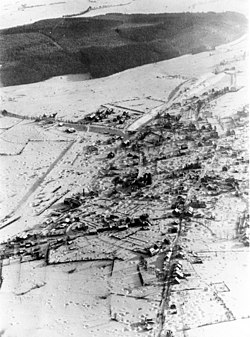
The Battle of St. Vith was an engagement in Belgium fought during the Allied advance from Paris to the Rhine in World War II. It was one of several battles on December 16, 1944 constituting the opening of Germany's Ardennes counteroffensive.
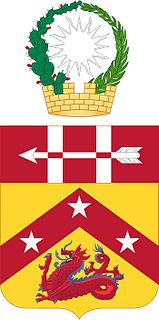
The 3rd Air Defense Artillery Regiment is an air defense artillery regiment of the United States Army, first formed in 1821 as the 3rd Regiment of Artillery.

The 78th Field Artillery Regiment is a field artillery regiment of the United States Army. Initially activated on 1 July 1916, the 78th Field Artillery Battalion did not see action in World War I, but would later be reactivated at the start of World War II and participate in the campaigns for Algeria-French Morocco, Sicily, Normandy, Northern France, Ardennes-Alsace, Central Europe, and the Rhineland with the 2d Armored Division. The 78th Artillery Battalion's six batteries were reorganized into separate battalions in 1957, with the 1st Battalion, 78th Field Artillery being the only remaining active unit of the 78th Field Artillery. The 1st Battalion, 78th Field Artillery is assigned to the 428th Field Artillery Brigade, supporting the Fires Center of Excellence mission through the conduct of Initial Entry Training in order to provide the Army with combat ready Field Artillery Soldiers. The 1st Battalion, 78th Field Artillery conducts Advanced Individual Training for the 13-series Military Occupational Specialties (MOS) of 13B, 13F, 13J, 13M, and 13R.
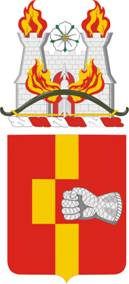
The 92nd Field Artillery Regiment is an inactive parent regiment of the Field Artillery Branch of the United States Army. It was constituted in 1933, with its last active battalions, the 1st and 3rd Battalions, inactivated in 1996.

The Battle of Clervaux or the Battle for Clervaux was an opening engagement of the Battle of the Bulge that took place in the town of Clervaux in northern Luxembourg. It lasted from December 16 to 18, 1944. German forces encircled numerically inferior American forces, primarily from the 110th Regiment and the 109th Field Artillery Battalion, and quickly forced them to surrender. The battle has been referred to as the Luxembourg "Alamo".
The 62nd Air Defense Artillery Regiment is an Air Defense Artillery regiment in the United States Army. The lineages of some of the units that have been part of the 62nd Air Defense Artillery and its predecessors give the regiment campaign credit for the War of 1812.
The 82nd Armored Reconnaissance Battalion was a part of the 2nd Armored Division, and was activated July 15, 1940, at Fort Benning, Georgia, for World War II. The organization was made up of trained men, from cavalry and reconnaissance units. The reconnaissance battalion was known as the "eyes and ears", of the 2nd Armored Division.
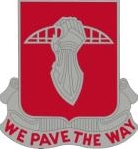
17th Armored Engineer Battalion are part of the 2nd Armored Division "Hell on Wheels". During World War II, they were active in North African Campaign, and Western Europe Campaign. 17th Armored Engineer Battalion was founded on 1 October 1933 as part of the USS Army. First called 17th Engineer Battalion, Motorized. It was renamed on 10 July 1940 to 17th Engineer Battalion (Armored) and assigned to the 2d Armored Division. The unit became active and started training 15 July 1940 at Fort Benning, Georgia. Renamed again on 8 January 1942 as the 17th Armored Engineer Battalion. The Battalion is now based at Fort Hood, Texas. Battalion motto is We pave the way. Task of the 17 include construction and demolition tasks under combat conditions, like constructing and breaching trenches, tank traps and other fortifications, bunker construction, bridge and road construction. Along with building destruction bridges and other physical work in the battlefield are needed. They also lay or clear land mines. The 17th facilitates the movement and support of friendly forces while slowing the enemy's forces.
















